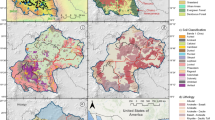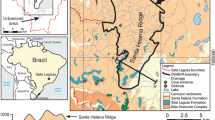Abstract
Quantifying the spatial and temporal distribution of natural groundwater recharge is usually a prerequisite for effective groundwater modeling and management. As flow models become increasingly utilized for management decisions, there is an increased need for simple, practical methods to delineate recharge zones and quantify recharge rates. Existing models for estimating recharge distributions are data intensive, require extensive parameterization, and take a significant investment of time in order to establish. The Wisconsin Geological and Natural History Survey (WGNHS) has developed a simple daily soil–water balance (SWB) model that uses readily available soil, land cover, topographic, and climatic data in conjunction with a geographic information system (GIS) to estimate the temporal and spatial distribution of groundwater recharge at the watershed scale for temperate humid areas. To demonstrate the methodology and the applicability and performance of the model, two case studies are presented: one for the forested Trout Lake watershed of north central Wisconsin, USA and the other for the urban-agricultural Pheasant Branch Creek watershed of south central Wisconsin, USA. Overall, the SWB model performs well and presents modelers and planners with a practical tool for providing recharge estimates for modeling and water resource planning purposes in humid areas.
Résumé
Quantifier les distributions temporelle et spatiale de la réalimentation naturelle des eaux souterraines est en règle générale un préalable à une modélisation et une gestion efficaces des eaux souterraines. Etant donné que les modèles numériques sont utilisés de manière croissante dans les prises de décisions en matière de gestion, il existe un besoin accru pour des méthodes simples et pratiques, afin de délimiter les zones d’alimentation et de quantifier les recharges associées. Les modèles existants, destinés à l’estimation de la répartition des réalimentations, demandent énormément de données, un paramétrage long, et un investissement conséquent en temps de mise en œuvre. Le Wisconsin Geologic and Natural History Survey (WGNHS) a développé un modèle simple basé sur un bilan en eau quotidien dans les sols (SWB); il utilise les données directement disponibles sur les sols, l’occupation des sols, la topographie et le climat, en conjonction avec un Système d’Information Géographique, afin d’estimer les distributions temporelle et spatiale de la réalimentation des eaux souterraines à l’échelle du bassin versant, pour les zones humides tempérées. Afin de démontrer la méthodologie, l’applicabilité et les performances du modèle, deux applications sont présentées: la première sur le bassin versant boisé de Trout Lake au centre-nord du Wisconsin (Etats-Unis), et le second sur le bassin versant agricole et urbanisé de Pheasant Branch Creek au centre-sud du Wisconsin. Le modèle SWB se comporte globalement bien, et offre aux modélisateurs un outil fonctionnel pour estimer les réalimentations, dans le cadre de modélisations et de plans de gestion des ressources en eau souterraine dans les zones humides.
Resumen
La cuantificación de la distribución espacial y temporal de la recarga natural de agua subterránea es un requisito previo para una modelación y una gestión efectivas de las aguas subterráneas. Dado que se está incrementando el uso de los modelos de flujo para la toma de decisiones de gestión, existe una necesidad creciente de métodos simples y prácticos para delimitar las zonas de recarga y cuantificar los rangos de la misma. Los modelos existentes para la estimación de la distribución de la recarga requieren datos intensivos, una parametrización extensiva y una inversión de tiempo significativa para ser establecidos. El Servicio Geológico y de Historioa Natural de Wisconsin (WGNHS) ha desarrollado un modelo simple de balance diario de agua en el suelo (SWB) que usa de forma sencilla datos disponibles de suelo, de cobertera, topográficos y climáticos conjuntamente con un Sistema de Información Geográfica (GIS) para estimar la distribución espacial y temporal de la recarga de aguas subterráneas a escala de cuenca para zonas templadas húmedas. Para demostrar la metodología, aplicabilidad y el comportamiento del modelo, se presentan dos casos: uno en la cuenca boscosa de Trout Lake, en la zona Norte-Central de Wisconsin, USA y el otro en la Cuenca urbano-agrícola de Pheasant Branch Creek, Sur-Centro de Winconsin, USA. En conjunto, el modelo SWB funciona bien y presenta a los modeladores y planificadores una herramienta práctica para llevar a cabo una estimación de la recarga para propósitos de modelación y planificación de los recursos de agua en zonas húmedas.







Similar content being viewed by others
References
Alley WM (1984) On the treatment of evapotranspiration, soil moisture accounting, and aquifer recharge in monthly water balance models. Water Resour Res 20(8):1137–1149
Anderson JR, Hardy EE, Roach JT, Witmer RE (1976) A land use and land cover classification system for use with remote sensor data. US Geol Surv Prof Pap 964:28
Blaney HF, Criddle WD (1966) Determining consumptive use for water developments. In: Proc ASCE Irrigation and Drainage Specifications Conf, University of California, Water Resources Center, Los Angeles, CA, pp 35
Bradbury CG, Rushton KR (1998) Estimating runoff-recharge in the southern Lincolnshire limestone catchment. UK J Hydro 211:86–99
De Vries JJ, Simmers I (2002) Groundwater recharge: an overview of processes and challenges. Hydrogeol J 10:5–17
Dripps WR (2003) The spatial and temporal variability of groundwater recharge within the Trout Lake basin of northern Wisconsin. PhD Thesis, University of Wisconsin, Madison, WI, USA
Dripps WR, Hunt RJ, Anderson MP (2006) Estimating recharge rates with analytic element models and parameter estimation. Ground Water 44(1):47–55
Eaton TT (1995) Estimating groundwater recharge using a modified soil-water budget method. In: Proc AWRA Wisconsin Nineteenth Annual Conf, Abstracts, AWRA, Middleburg, VA, USA, p 18
Foley JA, Prentice IC, Ramankutty N, Levis S, Pollard D, Sitch S, Haxeltine A (1996) An integrated biosphere model of land surface processes, terrestrial carbon balance, and vegetation dynamics. Glob Biogeochem Cycl 10(4):603–628
Gurda RF (1994) Linking and building institutions for a statewide land cover mapping program. GIS/LIS Conference Proceedings, Phoenix, AZ, USA, October 1994, pp 403–412
Haitjema HM, Kelson VA (1994) GFLOW user’s manual. Technical report. Haitjema Software, LLC, Indianapolis, IN, USA
Harbaugh AW, Banta ER, Hill MC, McDonald MG (2000) MODFLOW-2000, The U.S. Geological Survey Modular Groundwater model: user guide to modularization concepts and the groundwater flow process. US Geol Surv Open-File Rep 00–92
Howard KWF, Lloyd JW (1979) The sensitivity of parameters in the Penman evaporation equations and direct recharge balance. J Hydro 41:329–344
Hunt RJ, Steuer J (2000) Delineating a spring’s recharge area using numerical groundwater flow modeling and geochemical investigation. Technical report, Wisconsin Dept. of Natural Resources, Madison, WI, USA
Hunt RJ, Anderson MP, Kelson VA (1998) Improving a complex finite-difference groundwater flow model through the use of an analytic element screening model. Ground Water 36(6):1011–1017
Institute of Hydrology (1980) Low flow studies. Research report 1, Institute of Hydrology, Wallingford, UK
Jensen ME, Haise RH (1963) Estimating evapotranspiration from solar radiation. ASCE Proc 89(IR4):15–41
Krohelski JT, Bradbury KR, Hunt RJ, Swanson SK (2000) Numerical simulation of groundwater flow in Dane County, Wisconsin. Bulletin 98, Wisconsin Geological and Natural History Survey, Madison, WI, USA, p 31
Kucharik CJ, Foley JA, Delire C, Fisher VA, Coe MT, Lenters JD, Young-Molling C, Ramankutty N (2000) Testing the performance of a dynamic global ecosystem model: water balance, carbon balance, and vegetation structure. Glob Biogeochem Cycl 14(3):795–825
Leavesley GH, Lichty RW, Troutman BM, Saindon LG (1983) Precipitation-runoff modeling system: user’s manual. US Geol Surv Water Resour Invest Rep 4238:207
Lenters JD, Coe MT, Foley JA (2000) Surface water balance of the continental United States, 1963–1995: regional evaluation of the terrestrial biosphere model and the NCEP/NCAR reanalysis. J Geophys Res 105(D 17):22393–22425
Lerner DN, Issar AS, Simmers I (1990) Groundwater recharge: a guide to understanding and estimating natural recharge. Int Assoc Hydrogeol 8:345
Lewis FM, Walker GR (2002) Assessing the potential for significant and episodic recharge in southwestern Australia using rainfall data. Hydrogeol J 10:229–237
Moglen GE (2000) Effect of orientation of spatially distributed curve numbers in runoff calculations. J Am Water Resour Assoc 36(6):1391–1400
Poeter EP, Hill MC (1998) Documentation of UCODE: a computer code for universal inverse modeling. US Geol Surv Water Resour Invest Rep 98–4080:116
Potter KW, Bowser CJ (1995) Estimating the spatial distribution of groundwater recharge rates using hydrologic, hydrogeologic, and geochemical methods. Technical report, University of Wisconsin, Madison Water Resource Center, Madison, WI, USA, WRC-GRR-95.07
Rorabaugh MI (1964) Estimating changes in bank storage and groundwater contribution to streamflow. Int Assoc Sci Hydrol Publ 63:432–441
Rushton KR, Ward C (1979) The estimation of groundwater recharge. J Hydro 41:345–361
Rutledge AT (1993) Computer programs for describing the recession of groundwater discharge and for estimating mean groundwater recharge and discharge from streamflow records. US Geol Surv WRI 93–4121
Rutledge AT (1998) Computer programs for describing the recession of groundwater discharge and for estimating mean groundwater recharge and discharge from streamflow records: update. US Geol Surv Water Resour Invest Rep 98–4148
Scanlon BR, Cook PG (2002) Theme issue on groundwater recharge. Hydrogeol J 10:3–4
Scanlon BR, Healy RW, Cook PG (2002) Choosing appropriate techniques for quantifying groundwater recharge. Hydrogeol J 10:18–39
Steenhuis T, Van Der Molen W (1986) The Thornthwaite-Mather procedure as a simple engineering method to predict recharge. J Hydro 84:221–229
Steuer JJ (1999) A precipitation-runoff model for Pheasant Branch Creek, Middleton, WI. US Geological Survey Water Resources Division, Middleton, WI, USA
Swanson SK (1996) A comparison of two methods used to estimate groundwater recharge in Dane County, Wisconsin. MSc Thesis, University of Wisconsin, Madison, USA
Thornthwaite CW (1948) An approach toward a rational classification of climate. Geog Rev 38(1):55–94
Thornthwaite CW, Mather JR (1957) Instructions and tables for computing potential evapotranspiration and the water balance. Publ Climatol 10(3)
Turc L (1961) Estimation of irrigation water requirements, potential evapotranspiration: a simple climatic formula evolved up to date. Ann Agron 12(1):13–49
US Department of Agriculture, Natural Resources Conservation Service (1999) Soil survey geographic database for Vilas County, Wisconsin, USDA, Washington, DC
US Department of Agriculture, Soil Conservation Service (1978) Soil survey of Dane county, Wisconsin, USDA, Washington, DC
US Soil Conservation Service (1964) SCS national engineering handbook: hydrology, section 4. US Soil Conservation Service, Washington, DC
Acknowledgements
Support for this research was provided by the North Highland Lakes Long Term Ecological Research (LTER) Project funded by the National Science Foundation (DEB-9632853), the American Geophysical Union, the Department of Geology and Geophysics, UW-Madison, and the US Geological Survey Northern Temperate Lakes Water, Energy, and Biogeochemical Budgets (WEBB) project.
Author information
Authors and Affiliations
Corresponding author
Rights and permissions
About this article
Cite this article
Dripps, W.R., Bradbury, K.R. A simple daily soil–water balance model for estimating the spatial and temporal distribution of groundwater recharge in temperate humid areas. Hydrogeol J 15, 433–444 (2007). https://doi.org/10.1007/s10040-007-0160-6
Received:
Accepted:
Published:
Issue Date:
DOI: https://doi.org/10.1007/s10040-007-0160-6




